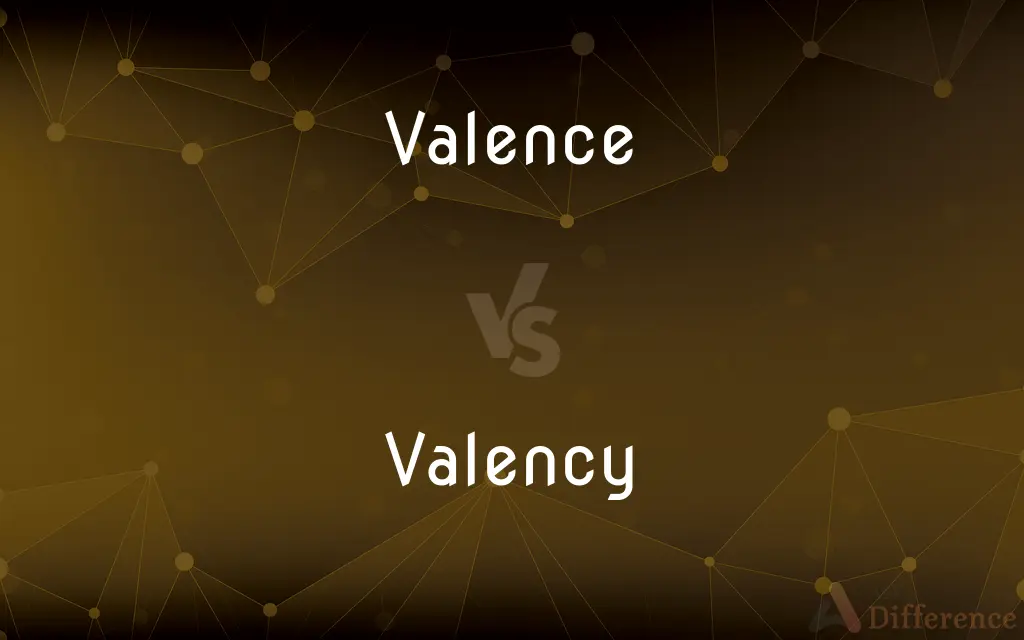Valence vs. Valency — What's the Difference?
By Fiza Rafique & Urooj Arif — Updated on March 20, 2024
Valence refers to the ability of atoms to combine, while valency is the number of electrons involved in bonding.

Difference Between Valence and Valency
Table of Contents
ADVERTISEMENT
Key Differences
Valence is a broad term that describes the ability of atoms or groups of atoms to combine with others, based on their electron configurations. It involves the concept of how atoms interact in chemical reactions to form compounds. On the other hand, valency is more specific and quantifiable, referring to the actual number of electrons an atom uses or loses, gains, and shares when it forms chemical bonds.
Valence encompasses not just the capacity to bond but also the type of bonds formed, such as ionic or covalent, and the resulting molecular structures. It's about understanding the chemical behavior of elements. Whereas valency is directly related to the electrons in the outermost shell of an atom, indicating how many electrons are available for bonding.
The concept of valence has evolved to include not just the combining capacity but also ideas like valence electrons (the electrons in the outermost shell that are involved in bonding) and valence orbitals (the orbitals that contain the valence electrons). Valency, by contrast, remains a fixed numeric value representing the number of valence electrons involved in the formation of chemical bonds.
In practice, valence is used to predict the chemical behavior of atoms in different contexts, considering factors like electron configuration and the presence of other atoms. Valency, while a part of this predictive process, is a more straightforward measure, often used in determining the stoichiometry of chemical compounds.
Valence can change depending on the chemical context and the presence of different elements, reflecting the versatile bonding capabilities of atoms. Valency, however, is generally considered a fixed characteristic of an element, representing its default bonding capacity based on its electron configuration.
ADVERTISEMENT
Comparison Chart
Definition
Refers to the ability of atoms to combine with others.
The specific number of electrons an atom uses in bonding.
Focus
Broad concept including types of bonds and molecular structures.
Specifically focuses on the number of bonding electrons.
Related Terms
Valence electrons, valence orbitals.
Often used interchangeably but less broadly.
Application
Predicting chemical behavior and bonding patterns.
Determining stoichiometry and simple bonding configurations.
Variability
Can vary depending on chemical context and combinations.
Generally fixed for a given element, based on electron configuration.
Compare with Definitions
Valence
Valence describes how well atoms or groups of atoms can connect with others to form molecules.
The valence of carbon in methane (CH4) is four, as it bonds with four hydrogen atoms.
Valency
Valency is the count of an atom's electrons that participate in bond formation.
Chlorine has a valency of one, as it needs one more electron to achieve a stable electron configuration.
Valence
It encompasses the types of chemical bonds atoms can form, like ionic or covalent.
Sodium (Na) has a valence that allows it to form ionic bonds with chlorine (Cl) to create table salt (NaCl).
Valency
Valency is grounded in an element's electron configuration, particularly the outer shell.
Magnesium has a valency of two, corresponding to its two outer electrons that can be lost to form bonds.
Valence
Valence involves understanding the electron arrangements that dictate an atom's bonding behavior.
The valence of nitrogen allows it to form three covalent bonds, as seen in ammonia (NH3).
Valency
For many elements, valency is a fixed number, indicating a standard bonding capacity.
The valency of hydrogen is one, reflecting its capacity to form one bond.
Valence
Valence reflects the versatile nature of atomic bonding, changing with different chemical contexts.
Carbon's valence allows it to form diverse compounds, from simple gases like CO2 to complex molecules like glucose (C6H12O6).
Valency
It's used to understand basic bonding and chemical reactions.
The valency of sodium and chlorine being one explains the formation of NaCl.
Valence
The concept helps predict the structures of molecules and compounds.
The valence of oxygen allows it to form two bonds, resulting in water (H2O) when combined with hydrogen.
Valency
Valency is crucial in determining the ratios of atoms in chemical formulas.
The valency of oxygen (2) and hydrogen (1) determines the H2O formula for water.
Valence
Another term for valency
Valency
The combining power of an element, especially as measured by the number of hydrogen atoms it can displace or combine with
Carbon always has a valency of 4
Valence
The combining capacity of an atom or group of atoms as determined by the number of electrons it can lose, add, or share when it reacts with other atoms or groups. Also called oxidation state.
Valency
Variant of valence.
Valence
An integer used to represent this capacity, which may be given as positive or negative depending on whether electrons are lost or gained, respectively
The valences of copper are +1 and +2.
Valency
Senseid|en|chemistry}}{{alternative form of valence
Valence
The number of binding sites of a molecule, such as an antibody or antigen.
Valency
The capacity of something to combine with other things, as for example the capability of a vaccine as measured by the number of pathogen serotypes that it can counteract.
Vaccine valency
Valence
The number of different antigens contained in a vaccine, corresponding to the number of pathogens that it is active against.
Valency
The number of edges connected to a vertex in a graph.
Valence
(Psychology) The degree of attraction or aversion that an individual feels toward a specific object or event.
Valency
Senseid|en|linguistics}}{{alternative form of valence
Valence
(Linguistics) The number and type of arguments that a lexical item, especially a verb, can combine with to make a syntactically well-formed sentence, often along with a description of the categories of those constituents. Intransitive verbs (appear, arrive) have a valence of one—the subject; some transitive verbs (paint, touch), two—the subject and direct object; other transitive verbs (ask, give), three—the subject, direct object, and indirect object.
Valency
(uncountable) Importance, significance.
Valence
The capacity of something to unite, react, or interact with something else
"I do not claim to know much more about novels than the writing of them, but I cannot imagine one set in the breathing world which lacks any moral valence" (Robert Stone).
Valency
See Valence.
Valence
The combining capacity of an atom, functional group, or radical determined by the number of atoms of hydrogen with which it will unite, or the number of electrons that it will gain, lose, or share when it combines with other atoms, etc.
Valency
The phenomenon of forming chemical bonds
Valence
The number of binding sites of a molecule, such as an antibody or antigen.
Valency
(biology) a relative capacity to unite or react or interact as with antigens or a biological substrate
Valence
The number of arguments that a verb can have, including its subject, ranging from zero to three or, less commonly, four.
In this assignment you will analyze each of the following sentences and determine the valence of the highlighted verb.
Valency
(chemistry) a property of atoms or radicals; their combining power given in terms of the number of hydrogen atoms (or the equivalent)
Valence
A one-dimensional value assigned by a person to an object, situation, or state, that can usually be positive (causing a feeling of attraction) or negative (repulsion).
Anger and fear have negative valence
Valence
The value which a person places on something.
Valence
Alternative spelling of valance
Valence
The degree of combining power of an atom (or radical) as shown by the number of atoms of hydrogen (or of other monads, as chlorine, sodium, etc.) with which it will combine, or for which it can be substituted, or with which it can be compared; thus, an atom of hydrogen is a monad, and has a valence of one; the atoms of oxygen, nitrogen, and carbon are respectively dyads, triads, and tetrads, and have a valence respectively of two, three, and four.
Valence
(biology) a relative capacity to unite or react or interact as with antigens or a biological substrate
Valence
(chemistry) a property of atoms or radicals; their combining power given in terms of the number of hydrogen atoms (or the equivalent)
Common Curiosities
Can valence change?
Yes, an atom's valence can vary depending on its chemical environment and the atoms it interacts with, influencing the types of bonds and structures formed.
How is valency defined?
Valency is defined as the number of electrons an atom can lose, gain, or share when it forms chemical bonds, typically a fixed value for each element.
How does valence differ from valency?
Valence is a broader concept that includes the atom's bonding capacity, types of bonds, and resulting structures, while valency specifically refers to the fixed number of electrons involved in bonding.
What is valence in chemistry?
Valence refers to an atom's capacity to bond with other atoms, determined by its electron configuration and the types of bonds it can form.
Can an element have multiple valencies?
Yes, some elements can have multiple valencies, depending on the compounds they form and their oxidation states.
Is valency always a fixed number?
For many elements, valency is a fixed number based on their stable electron configurations, but some elements can exhibit different valencies in various compounds.
How do valence and valency relate to chemical reactions?
Both concepts are essential for understanding and predicting the outcomes of chemical reactions, including which atoms will bond and in what proportions.
What determines an atom's valency?
An atom's valency is determined by its electron configuration, especially the electrons in the outermost shell available for bonding.
Why is understanding valence important?
Understanding valence is crucial for predicting how atoms will interact in chemical reactions, the types of molecules they'll form, and their properties.
How are valence and valency used in chemical equations?
Valence and valency help balance chemical equations by ensuring that the number of electrons lost and gained in a reaction is equal, maintaining charge neutrality.
Share Your Discovery

Previous Comparison
Hospitable vs. Welcoming
Next Comparison
FBI vs. PoliceAuthor Spotlight
Written by
Fiza RafiqueFiza Rafique is a skilled content writer at AskDifference.com, where she meticulously refines and enhances written pieces. Drawing from her vast editorial expertise, Fiza ensures clarity, accuracy, and precision in every article. Passionate about language, she continually seeks to elevate the quality of content for readers worldwide.
Co-written by
Urooj ArifUrooj is a skilled content writer at Ask Difference, known for her exceptional ability to simplify complex topics into engaging and informative content. With a passion for research and a flair for clear, concise writing, she consistently delivers articles that resonate with our diverse audience.














































